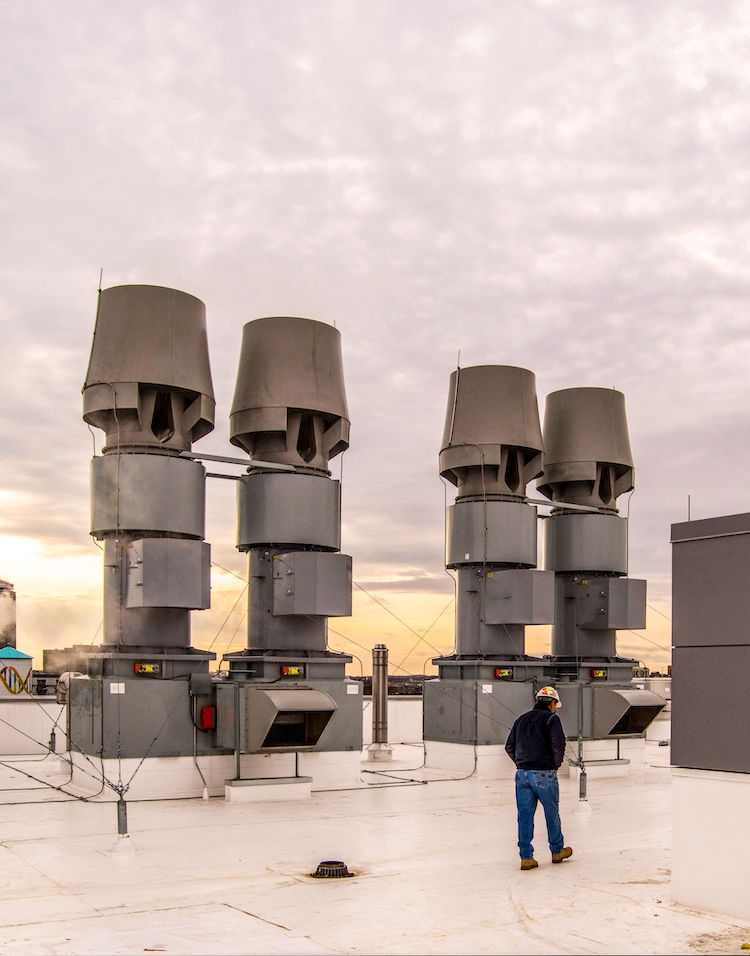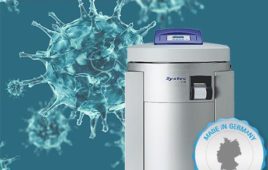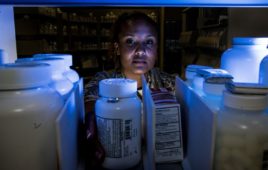By Jennifer Morgan and Michael Chusid

Rooftop equipment, like these laboratory exhaust fans on a pharmaceutical laboratory, require air terminals on top of them plus down conductors connected to the rest of the lightning protection system.
Photo: East Coast Lightning Equipment, Inc., LPS by Boston Lightning Rod, Co.
“What about the mice?” That was the first response of a postdoctoral fellow when asked what a lightning strike could do to her lab at a major biomedical research institute. In addition to electrocution, fire, and other animal welfare concerns, she is worried about the thousands of hours of research they represent. She elaborates, “Lightning could damage our experimental set-ups and custom-built electronic equipment, delay investigations, and make a real mess of the chemical, biological, and radioactive materials we have.”
“Fortunately,” she quips, “during thunderstorms, I can think about getting home safe and dry and not about whether I will have a lab to return to.” That’s because her lab and all structures on her company’s campus have lightning protection systems (LPS).
THEORY AND PRACTICE
Scientists will appreciate that, while the principles underlying lightning protection have been proven in practice for over 250 years since Ben Franklin’s experiments, they continue to be refined by ongoing investigations at lightning laboratories such as those operated by New Mexico Tech, University of Florida, National Oceanic and Atmospheric Administration (NOAA) National Severe Storms Laboratory, Sandia National Laboratories, and elsewhere. This work has been codified in internationally recognized standards, including:
- National Fire Protection Association (NFPA) 780 – Installation of Lightning Protection.
- UL 96A – Installation Requirements for Lightning Protection Systems.
- Lightning Protection Institute (LPI) 175 – Design – Installation – Inspection of Lightning Protection Systems
The standards have also been vetted and adopted by National Institutes for Health, NASA, National Weather Service, FAA, US Department of Defense, and other agencies and regulatory authorities.
This science-based consensus stands in contrast with the limited research behind products that claim to “prevent” lightning strikes or to protect large buildings with just a single lightning rod. These fringe products utilize discredited models such as “early streamer emissions” (ESE) and “charge dissipation” or are based on laboratory results using artificially generated lightning and test parameters that are not consistent with real lightning and storm conditions. These lab results, unfortunately, have not been replicated in field trials and do not reproduce the full effect of natural lightning—a force that can contain millions of volts and tens of thousands of amperes, is hotter than the surface of the sun, and can travel up to 100 miles from its point of origin before attaching to ground.
Cloud to ground lightning strikes occur approximately 25 million times annually in the U.S, according to the National Weather Service. While lightning density (flashes per square kilometer per year) varies regionally, every place in the country is vulnerable. It causes an estimated $5 billion in damage annually. The hazard is of the same magnitude as a major hurricane, a fact that is frequently overlooked because lightning incidents are more scattered geographically and throughout the year.
Another reason lightning damage is under reported is that many incidents are not the dramatic multi-alarm fire but damage to electronic devices and equipment and controls. The media grabs headlines like “Five-Alarm Fire Destroys Building, Lightning Blamed.” Don’t expect your evening newscast to lead with, “Lab Evacuated after Ventilation Fans Shut Down by Lightning”, “Electron Microscope didn’t see Lightning Coming.” or “Surging Electrons Destroy Atomic Absorption Spectrometer.”
Even if individual incidents are not cataclysmic on the national level, they can be devastating to a research team. As the director of facilities at a midwestern university explains, “I require lightning protection because I don’t want students or faculty to lose their research due to its omission.”
RISK ASSESSMENT
NFPA 780, Annex L, “Lightning Risk Assessment” provides two protocols for evaluating if a particular structure requires LPS. Its detailed algorithms can be used to evaluate complex installations with unusual risks. The “Simplified Risk Assessment,” however, can be conducted online by any concerned lab manager, safety officer, or design professional.
If vulnerability exceeds risk, a lightning protection system is required:
- Vulnerability of a structure is based on its height, the area of its footprint, and the flash density of the region based on meteorological records.
- Risk is determined by the building’s surroundings, construction materials, ease of evacuation, value and combustibility of contents, and the consequences of lightning damage.
NFPA 780 further states, “There are some cases where the need for protection should be given serious consideration regardless of the outcome of the risk assessment.” With respect to laboratories, these include:
- Facilities essential to public health and safety.
- Continuity of mission critical services.
- Tall isolated structures, including antenna.
- Buildings containing explosive, flammable, or hazardous materials that could be detrimental to environment.
- Hospital-based facilities and laboratories with valuable animals. An executive at a major hospital explains, “Without lightning protection, I can’t risk having someone on the operating table during a thunderstorm.”
- Buildings containing irreplaceable cultural heritage.
BASICS OF LPS
Lightning protection requires a whole-building solution. The standards call for a network of air terminals (lightning rods), lightning conductors, and ground electrodes to create multiple safe, low-resistance paths between the top of a structure (including rooftop equipment) and the Earth. The structural system, computer server racks, HVAC, plumbing, and other metallic systems within the building have to be bonded to achieve electrical equipotential, and all the center’s grounding systems have to be interconnected.
In addition to the elements of the lightning protection system that provide structural protection, it is essential to provide protection for the building’s electrical and electronic systems. The standards require the installation of Surge Protective Devices (SPDs) on all data, communication, and power lines entering a structure. These devices operate as a first line of defense. A survey of the exposure to lightning and surge damage should be conducted and it is often best to install additional SPD’s at subpanels and specific pieces of equipment.
An LPS professional, certified by the Lightning Protection Institute, should be part of the laboratory’s design and construction team. The LPS professional must also collaborate with the laboratory’s facility management team to assure proper design and installation of the LPS.
Few building code officials or fire marshals include lightning protection in their building inspections. Because of this, a Master Installation Certificate from the Lightning Protection Institute – Inspection Program (LPI-IP) should be required to make sure the LPS is installed correctly.
LAB SAFETY POLICY
Lightning protection should be incorporated into laboratory safety standards. Here are points to consider:
- “When Thunder Roars, Go Indoors!” Researchers out in the field are especially vulnerable to injury or death due to lightning strike. If you can hear thunder, seek shelter in an enclosed building or a vehicle with a metal roof. Close windows, and stay inside until 30 minutes after thunder has passed. Additional safety information is at cdc.gov/features/lightning-safety/index.html.
- Train the facility’s operating staff and maintenance contractors to work around an LPS. For example, servicing rooftop mechanical equipment must be done with care to avoid damage to LPS conductors and connections.
- Conduct periodic visual examinations to ascertain LPS equipment is in place and that indicator lights on surge protective devices show they are operational.
- Consult a lightning safety professional to determine if the LPS needs to be extended or modified whenever new equipment is installed or the building modified.
- Contact the lightning safety professional every three years to renew the LPI-IP certificate.
Capital costs to install lightning protection is typically orders of magnitude less than that of the value of the equipment it protects and is an investment that can last the life of a building. Protecting a building against damage is intrinsically sustainable and a lightning protection system can contribute to meeting green building goals. Lightning can accompany hurricanes, tornadoes, and other storms, and an LPS contributes to building resilience. This takes on urgency due to climate change. How global warming will affect lightning density and distribution in various regions has not been conclusively determined. We can be sure, however, that the question being researched in laboratories around the world.
Authors: Jennifer Morgan is co-owner of East Coast Lightning Equipment, Inc., the leading domestic producer of lightning protection hardware. Michael Chusid is an architect and Fellow of the Construction Specifications Institute. They are both certified by the Lightning Safety Alliance to provide continuing education programs and can be reached through ecle.biz.




Tell Us What You Think!